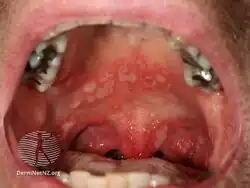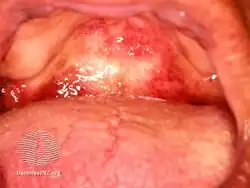Herpangina
| Herpangina | |
|---|---|
 | |
| An example of herpangina in a child | |
| Specialty | Infectious disease |
| Symptoms | Throat ulcers, fever[1] |
| Complications | Dehydration, aseptic meningitis, encephalitis[1] |
| Usual onset | 3 to 5 days post exposure[1] |
| Duration | 1 week[1] |
| Causes | Enteroviruses[1] |
| Diagnostic method | Based on symptoms and exam[1] |
| Differential diagnosis | Hand, foot, and mouth disease, Kawasaki disease, Rocky Mountain spotted fever, eczema herpeticum, toxic shock syndrome[1][2] |
| Treatment | Supportive care[3][1] |
| Medication | Ibuprofen and paracetamol (acetaminophen)[3][1] |
| Prognosis | Generally good[1] |
| Frequency | Relatively common[2] |
Herpangina is a type of viral infection that results in small blisters or ulcers in the back of the throat.[1] Other symptoms may include sore throat, fever, lose of appetite, and abdominal pain.[1][3] Onset is about 4 days after exposure.[1] Complications may rarely include dehydration, aseptic meningitis, or encephalitis.[1]
It is caused by viruses in the enterovirus group.[1] This includes coxsackieviruses A and B, enterovirus 71, and echovirus.[3] The disease often spreads between children in daycare or school.[1] Diagnosis is based on symptoms and examination after ruling out other potential causes.[1] In complicated cases testing the throat may be useful.[1]
Treatment is generally with supportive care such as ibuprofen and paracetamol (acetaminophen).[3][1] Sufficient fluids by mouth are recommended.[1] There is no specific antiviral.[1] Symptoms generally resolve within 4 days and mouth lesions heal within a week.[3]
Herpangina is relatively common and often occurs as an outbreak.[2][4] While it occurs most commonly in children, babies and young adults may also be affected.[1] Most cases occur in the summer or during the rainy season.[1] It was first characterized in 1920 by John Zahorsky.[3]
Signs and symptoms
Symptoms include sudden fever with sore throat, headache, loss of appetite, and often neck pain. Within two days of onset, an average of four or five (but sometimes up to twenty) 1 to 2 mm diameter grayish lumps form and develop into vesicles surrounded by redness. Over the next 24 hours, these become shallow ulcers, rarely larger than 5 mm diameter that heal in one to seven days. These lesions most often appear on the tonsillar pillars (adjacent to the tonsils), but also on the soft palate, tonsils, uvula, or tongue.[5]
A small number of lesions (usually two to six) form in the back area of the mouth, particularly the soft palate or tonsillar pillars. The lesions progress initially from red macules to vesicles and lastly to ulcerations, which can be 2–4 mm in size.
 An example of herpangina
An example of herpangina An example of herpangina
An example of herpangina
Cause
Typically spreads via the fecal-oral route or via respiratory droplets.
Diagnosis
A diagnosis can be made from clinical signs and symptoms, and treatment consists of minimizing the discomfort of symptoms.[5] It can be differentiated from herpetic gingivostomatitis by the positioning of vesicles - in herpangina, they are typically found on the posterior oropharynx, as compared to gingivostomatitis where they are typically found on the anterior oropharynx and the mouth.[6]
Treatment
Treatment is usually supportive only,[7] as the disease is self-limiting and usually runs its course in less than a week.
Epidemiology
- Most commonly affects infants and young children
- Typically occurs during the summer
Etymology
The term is derived from Greek herp 'creeping, snakelike' and Latin angina 'quinsy', literally "inflammation or swelling of the throat or part of the throat, esp. tonsillitis".[8][9]
References
- 1 2 3 4 5 6 7 8 9 10 11 12 13 14 15 16 17 18 19 20 21 22 23 Corsino, CB; Ali, R; Linklater, DR (January 2021). "Herpangina". PMID 29939569.
{{cite journal}}: Cite journal requires|journal=(help) - 1 2 3 "AboutKidsHealth". www.aboutkidshealth.ca. Archived from the original on 14 November 2020. Retrieved 1 May 2021.
- 1 2 3 4 5 6 7 Ongole, Ravikiran; N, Praveen B. (2014). Textbook of Oral Medicine, Oral Diagnosis and Oral Radiology - E-Book. Elsevier Health Sciences. p. 180. ISBN 978-81-312-3799-1. Archived from the original on 2021-08-28. Retrieved 2021-05-01.
- ↑ "Herpangina | DermNet NZ". dermnetnz.org. Archived from the original on 23 January 2021. Retrieved 1 May 2021.
- 1 2 "Herpangina". Merckmanuals.com. Merck. Archived from the original on 21 December 2014. Retrieved 21 December 2014.
- ↑ Parrot, RH; Wolf, SI; Nudelman, J; Naiden, E; Huebner, RJ; Rice, EC; McCullough, NB (August 1954). "Clinical and laboratory differentiation between herpangina and infectious (herpetic) gingivostomatitis". Pediatrics. 14 (2): 122–9. PMID 13185685.
- ↑ "ULCERATIVE LESIONS OF THE ORAL CAVITY". Utmb.edu. Archived from the original on 7 September 2013. Retrieved 21 December 2014.
- ↑ "Oxford English Dictionary". Oed.com. Archived from the original on 29 November 2014. Retrieved 21 December 2014.
- ↑ "Quinsy - Define Quinsy at Dictionary.com". Dictionary.com. Archived from the original on 29 November 2014. Retrieved 21 December 2014.
External links
| Classification | |
|---|---|
| External resources |